Malacca (also spelled Melaka) is located on the west coast of the Malay Peninsula.
Did you know it was the first place in Southeast Asia that was colonised by Europeans? As such, a long list of historically significant buildings and stories still exist until today.
The city is an oasis for history lovers, but the food culture is worth taking a close-up look at as well.
Historic architecture
Conveniently positioned between Kuala Lumpur and Singapore, Malacca is an easy big city-escape with a bunch of interesting sights to explore.
Malacca was the first place in Southeast Asia to be visited by European colonists — Portuguese folks to be precise — in 1511, and from that moment European nations started their expansive colonisation of the region for many centuries to come.
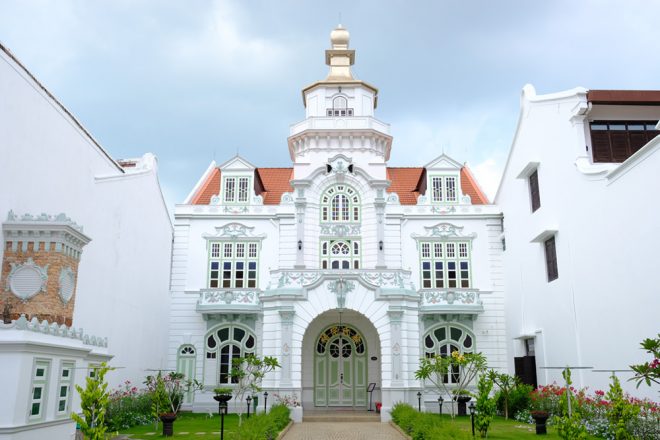
The eldest witness of the city’s long history is A Famosa Fortress, a short stroll away from the very centre of Malacca. The fortress was the first to be erected by the Portuguese conqueror Alfonso de Albuquerque, and it’s one of the oldest remaining ‘European’ structures in Southeast Asia. I did not read a lot about this ruin beforehand, so I had neutral expectations. The only remaining part is the Porta de Santiago, an original gate that used to be part of the great walls of A Famosa Fortress. Although there’s not a lot to see, I did feel the historical significance of this place.
A short but steep walk up the stairs beside the gate leads to the ruins of St. Paul’s Church. During its nearly 500-year-old history, this building functioned as a cathedral, a fortress, a lighthouse, and a gun powder house. The ruin doesn’t have a roof anymore, but the walls are still standing. In the courtyard lies a Dutch graveyard with impressive tombstones. The Dutch and English ruled here for a shorter and longer time after the Portuguese started their trading activities first.
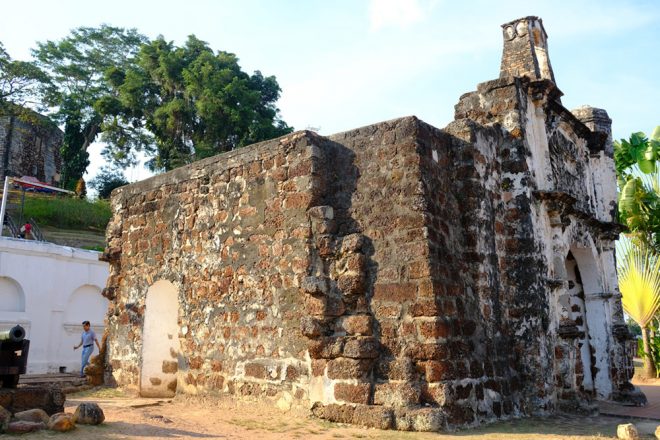
Dutch Square
Walking towards the city centre, I’m shocked by the heaps of tourists and deafening music coming from colourfully decorated tricycles parked at the Dutch Square. Tourists can take a ride through Malacca, sitting on these Hello Kitty and Pokémon-themed, man-powered tricycles with pounding speakers at the back.
You might be tempted to run away from this mayhem, but it’s best to ignore the funky bikes and head for the pinkish Christ Church. The Dutch built this cathedral back in 1753, and it’s a pretty sight to see. So is the nearby Clocktower and the Stadhuys – Dutch for city hall – a 17th-century structure in the same vivid colour as the Christ Church. These days the Stadhuys houses several museums, that give you an insight into Malaccan’s colonisation, artifacts, and history. The entrance fee to the Stadhuys is 10 MYR.
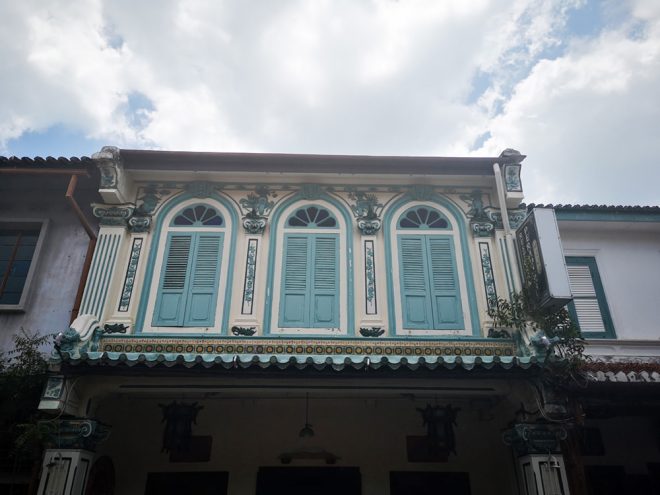
Baba & Nyonya Heritage House
Traders, planters and other happy few have called Malacca their home for over centuries. I’m a sucker for history and architecture, so I decided to set foot into the Baba & Nyonya Heritage House on Jalan Tun Tan Cheng Lock.
Baba refers to the gentleman and Nyonya to the lady. This term applies to the Chinese immigrants who have moved to Malaysia and assimilated in Malay society. This house was built in the 1860s by the Chan family, second-generation Chinese immigrants who established gambier plant — herbal medicine — and later rubber plantations. I can tell from the decorations inside this museum that their plant and rubber business was pretty successful. The interior of the house is stunning; woodcarvings, golden Chinese dragons, dresses and the elegant furniture really give you an understanding of the lives, habits and even costumes of prosperous Chinese families in 19th century Malaysia. Even more, because you get to explore countless rooms with different purposes. The ancestral room — in remembrance of family members who passed away — and the master bedroom with its art and beautifully decorated bed stand out.
In the back at the ground floor sits the former kitchen, where you can check the traditional tools and tableware. No doubt the house museum is chic but artsy and definitely interesting for the history idolizers out there.
You can choose to follow a group tour, or explore by yourself with a guidebook provided by the staff in your hand. Joining the tour costs 20 MYR per ticket, and you pay 16 MYR for a self-guided excursion with an informative book. Unfortunately, it’s not allowed to take photos inside the house.
Temples
When I continued walking through the centre, I suddenly bumped into an intriguing temple. The decoration is dazzling, with impressive animal sculptures, a pointy rooftop and red lampions all over the place. My nostrils are treated by incense sticks when I wander around the yard. This is Cheng Hoon Teng, founded in 1646 and the oldest Buddha temple in Malaysia. When properly dressed you can enter the temple, a world of wood carvings and worship.
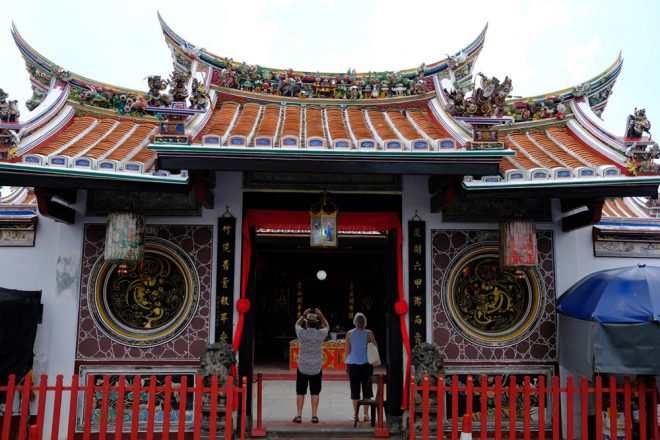
Opposite lies the Xiang Lin Si temple, which is pretty but not spectacular. Inside you can see several statues. The balcony on the first floor offers views of the Cheng Hoon Teng temple and the fascinating street life.
Malaccan specialties
You cannot leave Malaysia without having tried – at least some – bags of delicacies, coming from the Malay, Chinese and Indian kitchen originally. Malacca has its own twist to some Malay classics, such as laksa. I’m trying Nyonya laksa in Jonker Street Hawker Centre located on Jalan Kota Laksamada 1 / 2. This is probably the spiciest laksa I’ve had in years, and it has a rich coconut flavour since coconut milk is a signature ingredient in this type of laksa. Many more restaurants and stalls in Malacca sell nyonya laksa, and usually, the price is 7 MYR for a big bowl.
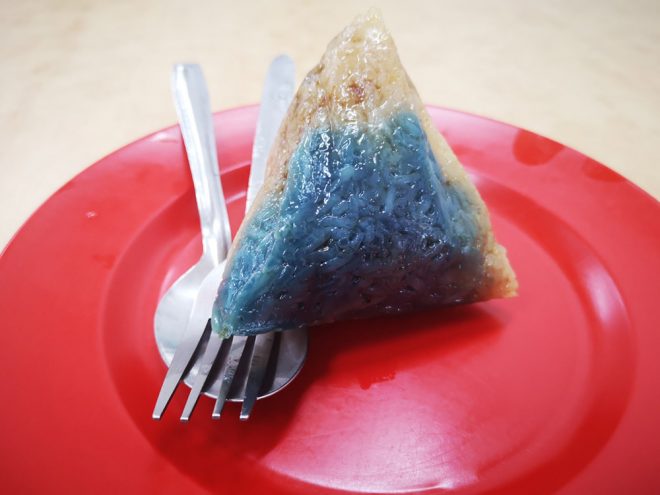
Another Malacca dish I was dying to try is the nyonya chang or glutinous rice dumpling. The looks are definitely in favour of this little in-between snack. Made with the colourant of blue pea flower, the sticky dumpling has an unusual but attractive appearance. Everyone who makes this little bundle of goodness has their own secrets and ingredients. But nyonya chang should at least contain pork, coriander seeds, mushroom, shallots, glutinous rice and of the course blue pea flower juice. I tried mine at 60 East & West Rendezvous at Lorong Hang Jebat. With 7 MYR it’s slightly overpriced – there are cheaper alternatives across the city – but the taste is pretty yummy.
Night market
Jonker Street is where tourists flock together on regular days, but at night during weekends, the famous lane gets truly packed. Basically, the shop owners just push their goods and food outside on carts when the night falls. So don’t worry when you’re not here for the weekend. You can get the same goodies and delicacies on any other day. But the atmosphere and the setting – stalls cramped between the historic shops of Jonker Street – makes it a great market to explore.
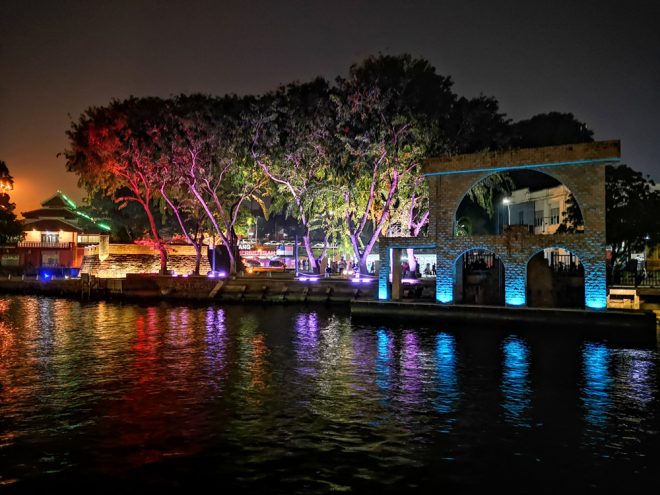
My culinary cravings continue while strolling around. The majority of the street food is fast food Asian style: quail egg omelette, Chinese hamburger, meat skewers and freshly squeezed fruit juices. The sidestreet opposite 7-Eleven has stalls with full-fledged meals like Chinese noodles – both wet and dry – and fried tofu. I decide to finish the night off with a durian puff, another famous Malaccan treat. The creamy inside is pungent and very strong, a strangely successful mixture of sweet and bitter. It’s this single bite that will last longest.
You can visit the market on Friday, Saturday and Sunday night. It starts around 6 pm. and it lasts past midnight.
Other eateries
Food is key in Malacca, and there’s more to discover beyond the night market and the typical Malaccan specialties. For a decent start of the day, I loved to go to Hoi Hiong Restoran, a Chinese buffet-style breakfast place. The variety of food here is terrific; veggies, tofu, meat, noodles and sauces. You can load your plate for about 10 MYR, a joke for the varied selection you can get.
Head to Pak Putra for incredible Indian food. This place is known for their tandoori chicken, but the naans and curry dishes genuinely are to die for. I enjoyed sitting outside, where there is a large seating area, and the tandoor ovens do overtime.
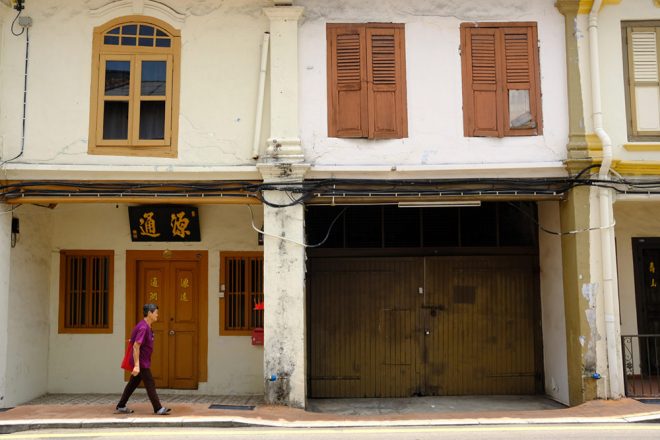
How to get to Malacca
You can travel from Kuala Lumpur to Malacca in a breeze by bus. The journey takes less than 2 hours, and the buses depart multiple times per day from Terminal Bersepadu Selatan. From Singapore, many buses head for Malacca daily as well. On average this trip takes about 4 hours. All buses arrive at Malacca Sentral, which is a bit outside the city centre. From here you can catch a local bus, taxi or even walk 4 kilometres into town if you’re in shape.
Some links may be affiliate links, meaning I may earn commission from products or services I recommend. For more, see site policies.
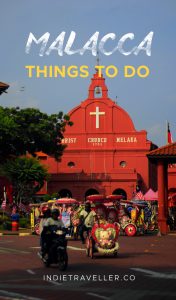
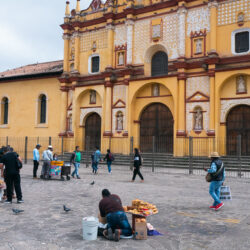
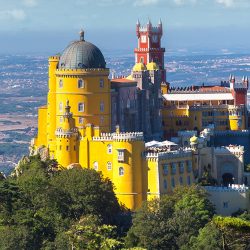




0 comments
Leave a comment
Your email address will not be published. Comments are manually moderated.